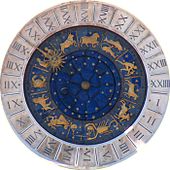| Scorpio | |
|---|---|
 | |
| Zodiac symbol | Scorpion |
| Duration (tropical, western) | October 22 – November 21 (2024, UT1)[1] |
| Constellation | Scorpius |
| Zodiac element | Water |
| Zodiac quality | Fixed |
| Sign ruler | Mars (traditional), Pluto (modern) |
| Detriment | Venus |
| Exaltation | None in traditional, Uranus in modern. |
| Fall | Moon |
| Astrology |
|---|
 |
| Background |
| Traditions |
| Branches |
| Astrological signs |
| Symbols |
Scorpio (♏︎) (Ancient Greek: Σκορπιός, romanized: Skorpiós, Latin for "scorpion") is the eighth astrological sign in the zodiac, originating from the constellation of Scorpius. It spans 210–240° ecliptic longitude. Under the tropical zodiac (most commonly used in Western astrology), the Sun transits this sign on average from October 23 to November 21.[2] Depending on which zodiac system one uses, someone born under the influence of Scorpio may be called a Scorpio or a Scorpionic.[2]




